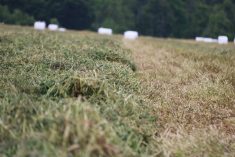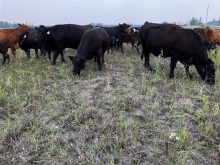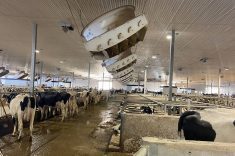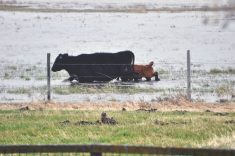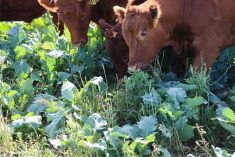Of all the weeds beef producers should focus on, Canada thistle is high on the list. Livestock avoid the prickly plant and it’s estimated to cost Canadian ag and forestry $7.5 billion in lost revenue annually.
Fall control on pasture might be one of the most effective tools in stopping growth of the weed, said one industry expert.
“If you hit them with a herbicide in the fall right after a hard frost, it will start sending all of its resources down to that big, massive root zone and it will send that herbicide down with it,” said Mark Versluys, specialties business leader with Corteva Agriscience.
Read Also

VIDEO: Watering system a cattle health win
Portable livestock watering system helps Manitoba beef producer combat foot rot cases on pasture.
“It will give you some excellent control going into the following year.”
Canada thistle is a pain, sometimes literally, and has been known to suck forage capacity from a pasture.
Those thistle roots are no joke when it comes to stealing precious moisture and nutrients from palatable pasture grasses, making it harder for those desired species to compete.
It’s no surprise that Canada thistle has been named by livestock producers as the worst pasture weed on the Prairies. The roots can grow six to 18 feet deep and 20 feet laterally. One plant can yield up to 5,000 seeds, which can germinate after only 10 days and spread to other points in the pasture.
According to a resource from the Beef Cattle Research Council in 2008, the roots of a thistle plant often spread one to two metres farther each season, although that number has been known to jump to six metres.
The same BCRC materials note that “root fragments as small as half a [centimetre] long can produce viable plants of this weed, making it very hard to control with cultivation.”
In Alberta, it is estimated that Canada thistle steals forage yield at a rate of two to one. Every pound of thistle biomass equates to two pounds less forage in that pasture, according to the BCRC.
Manitoba Agriculture’s profile of the weed says the thistle’s ability to outcompete for light, nutrients and water means that “Canada thistle can cause greater crop losses than any other broadleaf weed in Western Canada.”
Established plants can send new shoots every five to 15 cm, the province noted, and “a typical infestation produces 13-18 shoots per square metre.”
Corteva recommends an integrated pasture-management system including herbicides, grazing and fertilization to tackle Canada thistle and other weeds.
The company has three herbicides for Canada thistle. They include Grazon XC (Group 4 with picloram and 2, 4-D as active ingredients), Reclaim II (Groups 2 and 4, active ingredient aminopyralid) and Restore II (Group 4, aminopyralid and 2, 4-D).
Producers can consult the company or other agronomists for advice on which of these and other products is most suitable.
Multi-directional attack
Manitoba Agriculture warns farmers that “Canada thistle requires a multi-year, integrated control strategy,” which could include patch mowing, tillage (more applicable to annual crops) and herbicide.
Livestock producers tempted to pull out the iron to control a heavy infestation should know that fall tillage has mixed results. The province estimates that late fall tillage often reduces shoots by 20 per cent and delays future emergence, but can also aggravate a thistle problem.
“Small fragments often survive adverse conditions,” leading to a new wave of thistle.
“Because Canada thistle has a massive capacity to produce roots and shoots eventually growing up as new plants, killing the top-growth is like giving thistle a haircut. The only way to control the entire root system is to use a herbicide that translocates deeply into the roots,” Manitoba Agriculture says.
Right timing
Timing is everything when it comes to the year’s first herbicide application on Canada thistle, said Versluys, and the best window may have already passed.
“Really, what you want to do is hit that plant before it buds or pre-buds,” he said. “You can let it grow out a little bit to about 10 per cent growth, but you are pushing the envelope there.”
Agronomists can help figure out the best time for application. Versluys encouraged producers to familiarize themselves with the target weed spectrum.
“We have different solutions, we have three fantastic products. But there’s some overlap in the weed spectrum for each of them and there’s a lot of differences as well.
“So make sure you know what you’re going after and make sure that the timing on the weeds you’re going after is correct for when you’re going in to spray it.”
Graze before prickles emerge
Herbicides are just the first step in an integrated pasture management system, said Versluys.
“Herbicide solutions are not silver bullets. They’re not going to do everything that you need to do but they are a very important part and a first step of an integrated pasture-management program.”
The next step occurs in spring. Although not a good solution for major thistle infestations, livestock in rotational grazing systems can work on bud-stage Canada thistle.
“It’s a huge part, not just for Canada thistle but for all weeds to keep them in line,” said Versluys. “When you get animals into a pasture when the Canada thistle is quite small, they will eat the buds on them because they’re still somewhat tender.
“Of course, when they get bigger, that’s a different story altogether.”
Another effective tool is crop competition on forage and pasture.
Planting competitive grasses should come after herbicide applications, said Versluys.
“That’s why I say your first step should be a herbicide application to get rid of those weeds… so that when you’re spending the money on your fertilizer for the crop to extend those pastures, you’re just feeding the crop and not the weeds.”




